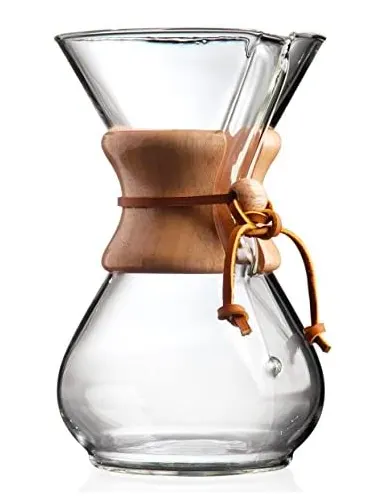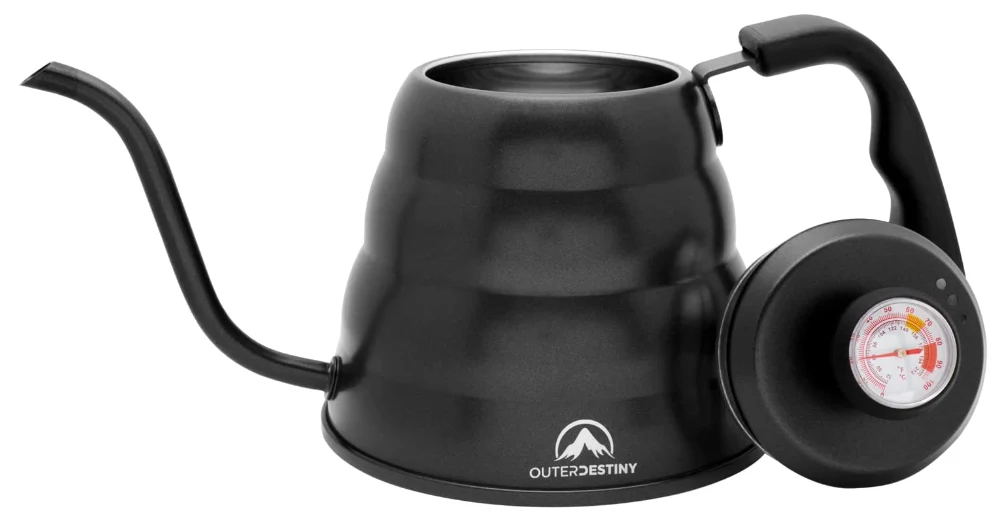Table of Contents
If you’re a coffee lover looking for a great cup of coffee, you know that there are many different ways to brew a cup of your favorite beverage, but you can’t go wrong with a pour over. In this article, we’ll compare the hario v60 vs chemex, two of the most popular pour over methods, to help you decide which one is best for you.
Let’s take a closer look at each one to see how they stack up against each other and help you decide which one is right for you!
These brewing techniques may appear to be quite similar at first glance. Especially considering that they’re both pour-over specialty coffee makers with different paper filters and they might even be constructed of the same material, depending on which model of the V60 you get.
But, there are a few key distinctions between these two coffee brewers, and one will most certainly be best for you.
Which one is it? Continue reading to find out!
What is Pour Over Coffee?
Pour over coffee is a coffee brewing method that is made by pouring hot water over ground coffee beans. The hot water extracts the flavors and oils from the beans, creating a rich and full-bodied cup of coffee.
Pour over coffee is often considered to be superior to other types of coffee, as it allows for greater control over the brewing process. As a result, pour over coffee often has a more complex flavor than coffee made using other methods.
If you’ve never tried pour over coffee and you’re looking for a delicious cup of joe, we highly recommend giving it a try!
What is the Hario V60?

The Hario V60 is a type of pour over coffee maker, invented in 2004 by the Japanese company, Hario.
Hario, originally Hiromu Sibata Works, was founded in 1921 and they were manufacturing and selling laboratory glassware.
In 1960, Hario started producing coffee equipment and their first product was the V60. The company has been manufacturing and selling the V60 ever since.
The V60 gets its name from the cone-shaped design of the brewer, which is at a 60 degree angle.
The Hario V60 is made of ceramic, glass, or plastic, and there are even two special editions, one with an olive wood base and the famed Copper edition. Each has a small hole at the bottom of the cone that allows hot water to flow through the coffee grounds and into your cup.
What is the Chemex?

The Chemex is another type of pour over coffee maker that was invented by German chemist, Peter Schlumbohm, in 1941.
In a career that spanned decades, he created over 300 patents, from cocktail shakers to automobiles. His primary concern was to make everyday items more practical, appealing, and enjoyable to use.
The CHEMEX® was designed by Schlumbohm with a view to not only make great coffee simple, but also to make the vessel beautiful. He was a chemist by trade, so he spent time studying and comprehending thoroughly the chemical process behind flavor and caffeine extraction from coffee beans.
It was because of this expertise that he came up with the double bonded CHEMEX ® paper filters, which guarantee a flawless extraction every time. The design of the carafe was inspired by the Bauhaus school of design and non-porous labware that would impart no taste of its own.
“The CHEMEX® is pure in both form and function. It has been recognized and awarded by both the scientific community as well as the art and design communities.”
Chemex
So, now that we know a little bit more about these two coffee makers, let’s compare them side by side!
Hario V60 vs Chemex: The Battle of the Pour Overs
When it comes to pour over coffee makers and deciding which one is best, there are several factors that you need to consider before making your choice:
Design
Let’s start with the design. The Hario V60 has a cone-shaped design, while the Chemex has an hourglass shape.
The cone-shaped design of the V60 allows for more control over the brewing process, as you can control the speed at which the water flows through the coffee grounds. This allows you to experiment with different brewing times and find the perfect time for your specific beans.
The Chemex, on the other hand, has a design that is more focused on simplicity. The hourglass shape of the brewer makes it easy to use and clean, as there are no nooks or crannies for coffee grounds to get stuck in.
Material
The material that the coffee maker is made out of is also an important consideration. The Hario V60 is available in ceramic, glass, or plastic, while the Chemex is made out of glass.
Ceramic and glass are both great materials for pour over coffee makers as they are non-porous and will not impart any flavors of their own into the coffee.
Plastic is also a non-porous material, but it is not as durable as ceramic or glass and it can start to absorb flavors over time.
The Chemex is made out of borosilicate glass, which is a type of glass that is known for its strength and durability.
It is also heat resistant, so you can put it directly on a hot stove to heat up the water.
Ease of Use
When it comes to ease of use, both the Hario V60 and Chemex are pretty straightforward.
To use the V60, all you need to do is add coffee grounds to the cone, pour hot water over them, and let it brew for the desired time.
The Chemex is just as easy to use. All you need to do is add coffee grounds to the filter, pour hot water over them, and let it brew for the desired time.
Clean Up
Clean up is also pretty easy for both coffee makers.
To clean the V60, all you need to do is remove the filter and coffee grounds and rinse it out with water.
To clean the Chemex, all you need to do is remove the filter and coffee grounds and rinse it out with water. You may also need to use a brush to clean the inside of the carafe if there is any coffee residue left behind.
Brewing Process
Now that we’ve compared the design and material of these two coffee makers, let’s talk about the brewing process.
The Hario V60 has a small hole at the bottom of the cone, which allows you to control the flow rate of water and experiment with different brewing times.
The Chemex also has a small hole at the bottom of the hourglass, but it is designed in such a way that the coffee grounds are evenly saturated and there is no need to stir.
Both of these coffee makers will produce a great cup of coffee, but the Hario V60 gives you more control over the brewing process, while the Chemex is simpler to use.
Tip: A gooseneck kettle is suggested for the best results when using either of these pour-over brewers. These narrow-spouted kettles allow you better control over the water flow, ensuring complete, uniform extraction of your coffee grounds.

Brewing Capacity
Do you make one cup at a time, or for a group? This is another major factor to consider when choosing between the two.
The Hario V60 is available in three different sizes: 01 (single cup), 02 (two cups), and 03 (three cups).
The Chemex is available in four different sizes: 03 (three cups), 06 (six cups), 08 (eight cups), and 10 (ten cups).
So, if you’re looking for a coffee maker that can brew a single cup or for a group, the Chemex is the better option.
Price
Finally, let’s talk about price. The Hario V60 ranges in price from $20 to $30, while the Chemex ranges in price from $30 to $50.
So, if you’re looking for a cheaper option, the Hario V60 is the way to go. If you’re willing to spend a bit more for a sturdier coffee maker, the Chemex is the better choice.
So, Which One Should You Choose?
After reading about the hario v60 vs chemex, it’s clear that both of these pour over coffee makers have a lot to offer. But, which one is right for you?
If you prefer to make one cup of coffee at a time or you want to opt for something more durable, such as plastic or stainless steel? Then the Hario V60 may be worth considering.
If you’re looking for a pour over coffee maker that is simpler to use, we recommend the Chemex. It is a beautiful brewer that can brew many cups at once. Take a closer look at the Chemex if you want an elegant machine that can brew multiple cups at once.
We hope this article has helped you decide which one is right for you! Thank you for reading.
Do you have a preference for the hario v60 vs chemex? Let us know in the comments below! And be sure to check out our other coffee-related articles for more tips and tricks on making the perfect cup of joe and to learn “All About That Coffee!”
Happy brewing! Happy sipping!

